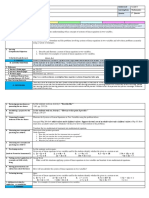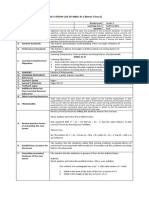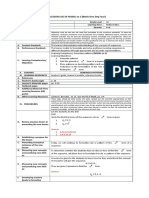PC I-27
PC I-27
Uploaded by
WilliamCopyright:
Available Formats
PC I-27
PC I-27
Uploaded by
WilliamOriginal Description:
Copyright
Available Formats
Share this document
Did you find this document useful?
Is this content inappropriate?
Copyright:
Available Formats
PC I-27
PC I-27
Uploaded by
WilliamCopyright:
Available Formats
DAILY LESSON LOG OF STEM_PC11AG-Ig-2 (Week Seven- Day Three)
School Grade Level 11
Teacher Learning Pre-Calculus
Area
Teaching Date
Quarter First Quarter
and Time
Objectives must be met over the week and connected to the curriculum standards. To meet the
objectives, necessary procedures must be followed and if needed, additional lessons, exercises
and remedial activities may be done for developing content knowledge and competencies.
I. OBJECTIVES These are assessed using Formative Assessment Strategies. Valuing objectives support the
learning of content and competencies and enable children to find significance and joy in
learning the lessons. Weekly objectives shall be derived from the curriculum guides.
A. Content Standards The learner demonstrates understanding of key concepts of conic sections
and systems of nonlinear equations.
B. Performance Standards The learner is able to model situations appropriately and solve problems
using conic sections and systems of nonlinear equations
Learning Competency:
Solves situational problems involving systems of nonlinear equations.
STEM_PC11AG-Ig-2
Learning Objectives:
C. Learning Competencies
1. Applies substitution, elimination, and graphing techniques in solving
/ Objectives
situational problems involving systems of nonlinear equations.
2. Solves situational problems involving systems of nonlinear equations.
3. Show appreciation to the concept of solving situational problems
involving systems of nonlinear equations.
II. CONTENT Solutions of Non-Linear Equations
III.LEARNING RESOURCES
A. References
1. Teacher’s Guide pages pp. 74-80
2.Learner’s Materials pages pp. 73-77
3.Textbook pages
4.Additional Materials from
Learning Resource (LR) portal
B. Other Learning
Resources
These steps should be done across the week. Spread out the activities appropriately so that
pupils/students will learn well. Always be guided by demonstration of learning by the pupils/
students which you can infer from formative assessment activities. Sustain learning
IV.PROCEDURES systematically by providing pupils/students with multiple ways to learn new things, practice the
learning, question their learning processes, and draw conclusions about what they learned in
relation to their life experiences and previous knowledge. Indicate the time allotment for each
step.
The teacher asks students to recall the situational problems solved the
A. Review previous lesson
previous meeting and to point out what they learned about how to solve it
or presenting the new
and if they find anything difficult in solving it. The teacher makes ensure that
lesson (8 minutes)
majority if not all concerns are addressed.
The teacher presents the objectives of the lesson to the class and let the
B. Establishing a purpose for the
students solves situational problems involving systems of nonlinear
lesson (2 minutes)
equations.
B. Presenting examples/
instances of the new
lesson
(15minutes)
C. Discussing new
concepts and practicing
new skills #1
(10 minutes)
D. Discussing new
concepts and practicing
new skills #2
(10 minutes)
The teacher presents more problems as added exercise.
ACTIVITY 1 (By Group)
E. Developing mastery 1. The square of a certain number exceeds twice the square of
(leads to formative another number by 1/8 . Also, the sum of their squares is 5/16 .
assessment 3) Find possible pairs of numbers that satisfy these conditions.
(5 minutes) 2. Determine the value(s) of k such that the circle x 2+( y−6)2=36
and the parabola x 2 = 4ky will intersect only at the origin.
G.Finding practical applications
of concepts and skills in daily
living
H.Making generalizations and The teacher emphasizes on the mathematical concept of solving situational
abstractions about the lesson (2 problems involving systems of nonlinear equations.
minutes)
Solve the problem given:
Ram is speeding along a highway when he sees a police
motorbike parked on the side of the road right next to him. He
immediately starts slowing down, but the police motorbike
accelerates to catch up with him. It is assumed that the two
I. Evaluating vehicles are going in the same direction in parallel paths. The
Learning distance that Ram has traveled in meters t seconds after he
(8 minutes) starts to slow down is given by d(t) = 150 + 75t−1.2t 2. The
distance that the police motorbike travels can be modeled by
the equation d(t) = 4t 2. How long will it take for the police
motorbike to catch up to Ram?
J.Additional activities or
remediation
V.REMARKS
Reflect on your teaching and assess yourself as a teacher. Think about your
students’ progress. What works? What else needs to be done to help the
VI.REFLECTION pupils/students learn? Identify what help your instructional supervisors can
provide for you so when you meet them, you can ask them relevant
questions.
A.No. of learners who earned
80% of the evaluation
B.No. of learners who require
additional activities for
remediation who scored below
80%
C.Did the remedial lesson work?
No. of learners who have caught
up with the lesson.
D.No. of learners who continue
to require remediation
E.Which of my teaching
strategies worked well? Why did
these work?
F.What difficulties did I
encounter which my principal or
supervisor can help me solve?
G.What innovation or localized Developing mastery
materials did I use/ discover Evaluating Learning
which I wish to share with other
teachers
You might also like
- SEMI-DETAILED LESSON LOG IN MATHEMATICS 5 For CLASSROOM OBSERVATIONDocument7 pagesSEMI-DETAILED LESSON LOG IN MATHEMATICS 5 For CLASSROOM OBSERVATIONMARIS GRACE CARVAJAL88% (16)
- A Course in Behavioral Economics: Printed BookDocument1 pageA Course in Behavioral Economics: Printed BookyamaryuNo ratings yet
- I-Day 35Document3 pagesI-Day 35Rainman InsanityNo ratings yet
- 16.illustrate Systems of Linear EquationsDocument3 pages16.illustrate Systems of Linear EquationsMiriam Galicia100% (1)
- Daily Lesson Log M8Al - Iie - 2 (Week Five - Day Two) SchoolDocument2 pagesDaily Lesson Log M8Al - Iie - 2 (Week Five - Day Two) SchoolFlorita LagramaNo ratings yet
- Daily Lesson Log of Stem - Pc11Ag-If-G-1 (Week Six-Seven-Day Four)Document4 pagesDaily Lesson Log of Stem - Pc11Ag-If-G-1 (Week Six-Seven-Day Four)WilliamNo ratings yet
- GM I-20Document5 pagesGM I-20Edelmar BenosaNo ratings yet
- I-Day 36Document3 pagesI-Day 36Rainman InsanityNo ratings yet
- DAILY LESSON LOG OF M11GM - Ie-F-2 (Week Six - Day One) : Answer KeyDocument3 pagesDAILY LESSON LOG OF M11GM - Ie-F-2 (Week Six - Day One) : Answer KeyEdelmar BenosaNo ratings yet
- I-Day 31Document3 pagesI-Day 31Florita LagramaNo ratings yet
- BC Iii-32Document3 pagesBC Iii-32Apple Jean Dag-umanNo ratings yet
- I-DAY 37Document3 pagesI-DAY 37alexpica0404No ratings yet
- I-Day 38Document3 pagesI-Day 38julito iliganNo ratings yet
- DAILY LESSON LOG OF M11GM-Ih-i-1 (Week Nine - Day One)Document2 pagesDAILY LESSON LOG OF M11GM-Ih-i-1 (Week Nine - Day One)nelson maraguinotNo ratings yet
- DAILY LESSON LOG OF M11GM-Ih-i-1 (Week Nine - Day One)Document2 pagesDAILY LESSON LOG OF M11GM-Ih-i-1 (Week Nine - Day One)Nelson MaraguinotNo ratings yet
- I-Day 20Document3 pagesI-Day 20Diana Rose Bagui LatayanNo ratings yet
- I-Day 37Document3 pagesI-Day 37julito iliganNo ratings yet
- DAILY LESSON LOG OF M11GM-Ih-i-1 (Week Nine - Day One) : Log (2 X 1) Log (x+2) Log 3Document2 pagesDAILY LESSON LOG OF M11GM-Ih-i-1 (Week Nine - Day One) : Log (2 X 1) Log (x+2) Log 3Karen MacaranasNo ratings yet
- I-Day 12Document3 pagesI-Day 12Veronica LopezNo ratings yet
- I-Day 13Document3 pagesI-Day 13Ma. Esperanza VenturaNo ratings yet
- BC Iv-5Document2 pagesBC Iv-5richard andresNo ratings yet
- I-Day 14Document3 pagesI-Day 14Ma. Esperanza VenturaNo ratings yet
- DAILY LESSON LOG OF M11GM-Ia-4 (Week One-Day Four)Document3 pagesDAILY LESSON LOG OF M11GM-Ia-4 (Week One-Day Four)Gladzangel LoricabvNo ratings yet
- I-Day 32Document4 pagesI-Day 32Rainman InsanityNo ratings yet
- DAILY LESSON LOG OF M11GM-Ia-4 (Week One-Day Three)Document3 pagesDAILY LESSON LOG OF M11GM-Ia-4 (Week One-Day Three)Gladzangel LoricabvNo ratings yet
- BC Iv-6Document3 pagesBC Iv-6Bernardo GaborniNo ratings yet
- BC Iii-31Document4 pagesBC Iii-31Apple Jean Dag-umanNo ratings yet
- I-Day 33Document7 pagesI-Day 33Rainman InsanityNo ratings yet
- PC Ii-14Document6 pagesPC Ii-14Fritzie Jane Babia BayotlangNo ratings yet
- BC Iv-29Document5 pagesBC Iv-29Bernardo GaborniNo ratings yet
- I-Day 27Document3 pagesI-Day 27Florita LagramaNo ratings yet
- DAILY LESSON LOG OF STEM - PC11SMI-Ij-1 (Week Ten-Day Two)Document3 pagesDAILY LESSON LOG OF STEM - PC11SMI-Ij-1 (Week Ten-Day Two)Lovely Ann DomasigNo ratings yet
- MATH G11 GM I Day 4Document3 pagesMATH G11 GM I Day 4AJ Diawara CusayNo ratings yet
- Teaching Date and TimeDocument5 pagesTeaching Date and TimeFlorita LagramaNo ratings yet
- I-Day 28Document2 pagesI-Day 28EDITHA PAGUYONo ratings yet
- Addtional Mathematics Learning Planner Template_MAIN (1)Document132 pagesAddtional Mathematics Learning Planner Template_MAIN (1)Adrah DavidNo ratings yet
- Find The Missing Term in A ProportionDocument4 pagesFind The Missing Term in A ProportionHERRENELLE DELA CRUZNo ratings yet
- COT 3 Math 8Document5 pagesCOT 3 Math 8Marvin Jay LulabNo ratings yet
- II-Day 8Document2 pagesII-Day 8Sir AsherNo ratings yet
- DEMO MeasurementDocument4 pagesDEMO MeasurementRydan MinorNo ratings yet
- Gen Math I - 4Document3 pagesGen Math I - 4Gladzangel LoricabvNo ratings yet
- BC Iv-27Document5 pagesBC Iv-27Bernardo GaborniNo ratings yet
- Daily Lesson Log of M8Al-Ib-2 (Week 2 Day 4) : X X - 15 and 15 - 2x - XDocument3 pagesDaily Lesson Log of M8Al-Ib-2 (Week 2 Day 4) : X X - 15 and 15 - 2x - Xzirconis10No ratings yet
- I-Day 9Document3 pagesI-Day 9Marivic Compahinay DacaraNo ratings yet
- I-Day 39Document4 pagesI-Day 39julito iliganNo ratings yet
- BC Iv-9Document2 pagesBC Iv-9sevynNo ratings yet
- II-Day 7Document3 pagesII-Day 7Sir AsherNo ratings yet
- DAILY LESSON LOG OF STEM - PC11AG-Ic-3 (Week Three-Day Three)Document4 pagesDAILY LESSON LOG OF STEM - PC11AG-Ic-3 (Week Three-Day Three)REDEN ORIOLANo ratings yet
- IV-Day 20Document3 pagesIV-Day 20Florita LagramaNo ratings yet
- I-Day 13Document2 pagesI-Day 13JESSA LOU CAPAPASNo ratings yet
- Math 9 DLP Day 14Document4 pagesMath 9 DLP Day 14salvadorachillesvabetoNo ratings yet
- SP Iii-13Document3 pagesSP Iii-13ラミレス アンマリエNo ratings yet
- Daily Lesson Plan of M8Al-Ih-2: Annex 18 Deped Order No. 42, S, 2016Document2 pagesDaily Lesson Plan of M8Al-Ih-2: Annex 18 Deped Order No. 42, S, 2016Florita LagramaNo ratings yet
- DLL Math 10aDocument2 pagesDLL Math 10aNeuford Dawaton GatanNo ratings yet
- DAILY LESSON LOG OF M10AL-Ia-1 (Week One-Day Four) : Answer: 1. 4,16,32,128,512 2. 1,4,9,16,25Document3 pagesDAILY LESSON LOG OF M10AL-Ia-1 (Week One-Day Four) : Answer: 1. 4,16,32,128,512 2. 1,4,9,16,25Maricel F. Villafuerte100% (1)
- G10-MATHEMATICS-DLL-Q3-W8-March 20Document2 pagesG10-MATHEMATICS-DLL-Q3-W8-March 20MARK RAYMOND DOMINGONo ratings yet
- DAILY LESSON LOG OF STEM - PC11AG-Ic-3 (Week Three-Day Four)Document3 pagesDAILY LESSON LOG OF STEM - PC11AG-Ic-3 (Week Three-Day Four)REDEN ORIOLANo ratings yet
- Sept. 14 & 15Document7 pagesSept. 14 & 15CRISTOPHER BRYAN N. MAGATNo ratings yet
- G9 LP MODULE 7 LESSON 11.1 Solving Worded Problems Involving Right TrianglesDocument6 pagesG9 LP MODULE 7 LESSON 11.1 Solving Worded Problems Involving Right TrianglesEmmanuel SioNo ratings yet
- Lesson Plan Grade 4 MathDocument7 pagesLesson Plan Grade 4 MathRegine Malana67% (3)
- DAILY LESSON LOG OF M11GM-Ih-i-1 (Week Eight-Day One) : Log 10 000 Log 10 Log 256 Log 256 Log (x+2) (x+1) (x+1)Document5 pagesDAILY LESSON LOG OF M11GM-Ih-i-1 (Week Eight-Day One) : Log 10 000 Log 10 Log 256 Log 256 Log (x+2) (x+1) (x+1)Karen MacaranasNo ratings yet
- Terry Cook: A BibliographyDocument9 pagesTerry Cook: A BibliographyrgscarterNo ratings yet
- Theoretical Frameworks in National SecurityDocument14 pagesTheoretical Frameworks in National SecurityEarl Harry CañizaresNo ratings yet
- Successful Lesson Plan PDFDocument3 pagesSuccessful Lesson Plan PDFIkram100% (1)
- The Invention and History of The Printing PressDocument7 pagesThe Invention and History of The Printing PressUmut AlıntaşNo ratings yet
- Mohan and StokkeDocument23 pagesMohan and StokkeRakiah AndersonNo ratings yet
- Hinduism Meets DarwinismDocument66 pagesHinduism Meets DarwinismMeera Nanda100% (1)
- European and Latin American Social Scientists: As RefugeesDocument301 pagesEuropean and Latin American Social Scientists: As RefugeesDaniel Rocha ChavezNo ratings yet
- lISING LIT REVIEW PRESENTATIONDocument26 pageslISING LIT REVIEW PRESENTATIONSarah Dane LisingNo ratings yet
- Characters:: Sicily, An Outcropping Overlooking The Camp, 205 BC, SaturnaliaDocument4 pagesCharacters:: Sicily, An Outcropping Overlooking The Camp, 205 BC, SaturnaliaJovan JakicNo ratings yet
- Prophet MuhammadDocument16 pagesProphet Muhammadafeky11No ratings yet
- Mesopotamia V/S Indus Valley Civilization: BY Shiva Singh Xii-BDocument8 pagesMesopotamia V/S Indus Valley Civilization: BY Shiva Singh Xii-BVedant PanjabiNo ratings yet
- Building Science Fiction Worlds (Boni, 2017)Document27 pagesBuilding Science Fiction Worlds (Boni, 2017)João MassaroloNo ratings yet
- THEO 1000 Syllabus (Fall 2019)Document7 pagesTHEO 1000 Syllabus (Fall 2019)Benjamin WinterNo ratings yet
- Graphic OrganizerDocument1 pageGraphic OrganizerArabella E.No ratings yet
- Final Portfolio Cover LetterDocument2 pagesFinal Portfolio Cover Letterapi-321017157No ratings yet
- Year 3 English Summary of SOW 2019Document7 pagesYear 3 English Summary of SOW 2019Brian NixonNo ratings yet
- Communication StylesDocument33 pagesCommunication Stylesapexlegendsukraine1No ratings yet
- Dwirantwi, Eric AddoDocument88 pagesDwirantwi, Eric AddoRavNeet KaUrNo ratings yet
- 10 Principles in Communication TheoryDocument11 pages10 Principles in Communication TheoryJansheer ShahNo ratings yet
- Zaban11 Exam1 1Document2 pagesZaban11 Exam1 1Masoumeh RassouliNo ratings yet
- Adaption and Selection in C-E Translation of Political WritingsDocument4 pagesAdaption and Selection in C-E Translation of Political Writingsyang caiNo ratings yet
- Arimardan Mehra Research and SkillDocument25 pagesArimardan Mehra Research and Skilltilak mehraNo ratings yet
- DIIS Mideterm 1st Sem 19-20Document7 pagesDIIS Mideterm 1st Sem 19-20Bobson Lacao-cao100% (1)
- Parcial de Ingles PrimeroDocument13 pagesParcial de Ingles PrimeroAna Adela Trujillo Rodriguez100% (1)
- Week 4 - Suhaila Humairo SidiqDocument3 pagesWeek 4 - Suhaila Humairo Sidiq4D - SUHAILA HUMAIRO SIDIQ - 035No ratings yet
- Nietzsche's Sociology: 0884-8971/06/0300-0031/0 2007 Blackwell Publishing LTDDocument26 pagesNietzsche's Sociology: 0884-8971/06/0300-0031/0 2007 Blackwell Publishing LTDJulio ChamunNo ratings yet
- BUS 1101 Learning Journal Unit 1 2020Document2 pagesBUS 1101 Learning Journal Unit 1 2020joel konse33% (3)
- Jolly Phonics PresentationDocument33 pagesJolly Phonics Presentationpuancaca80% (10)

























































































